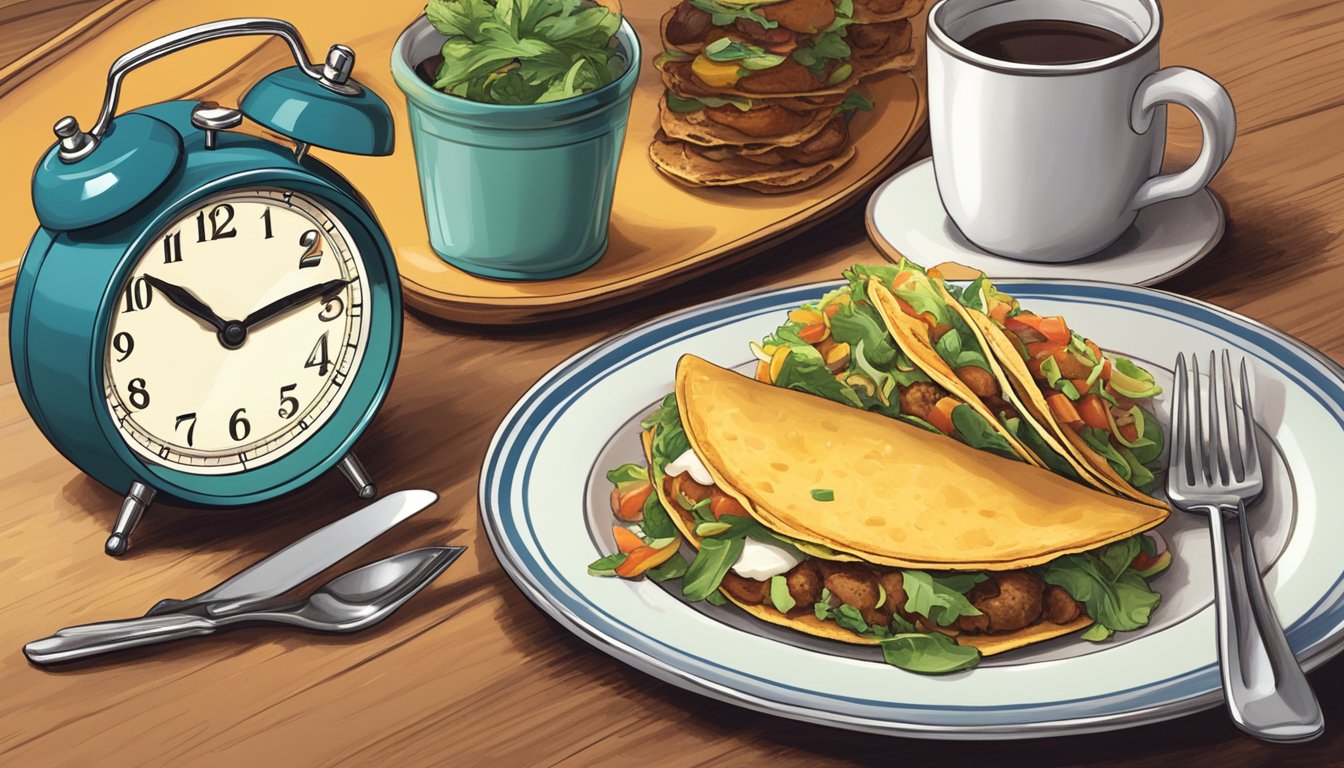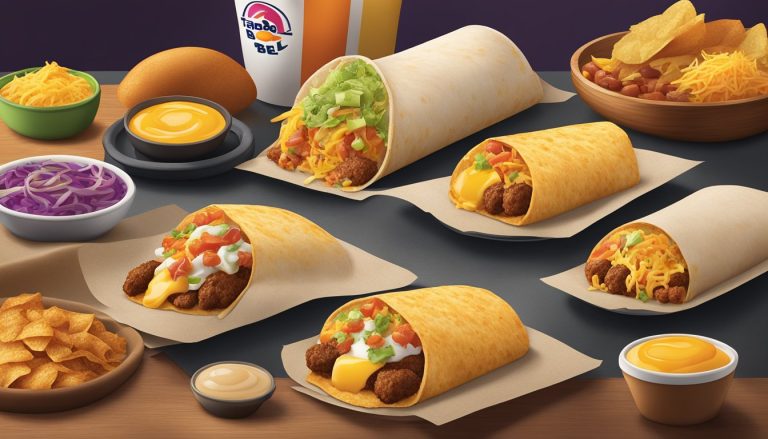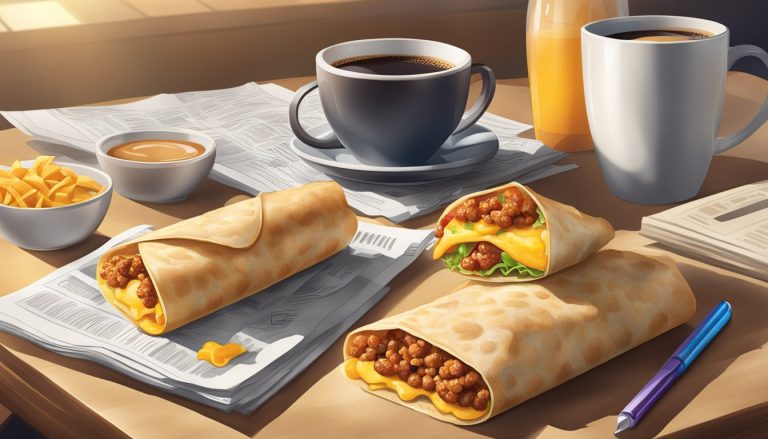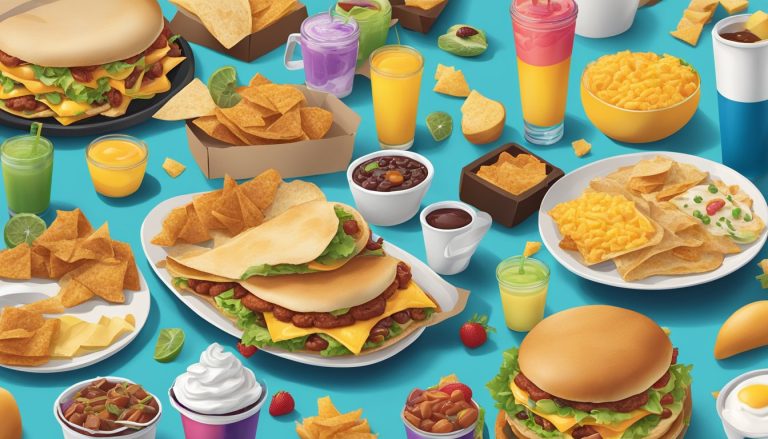Taco Bell’s breakfast marketing taps into a powerful emotional connection with consumers through nostalgia. The fast-food chain strategically leverages fond memories of past decades to create buzz and excitement around its morning menu offerings. By reintroducing beloved menu items from the 1960s through the 2000s, Taco Bell evokes a sense of familiarity and comfort that resonates with customers across generations.
This nostalgic approach extends beyond menu items to encompass retro-inspired merchandise and in-restaurant experiences designed to celebrate different eras. Taco Bell’s “Decades” campaign exemplifies how brands can effectively harness nostalgia in their marketing efforts. The campaign not only appeals to longtime fans but also introduces younger customers to iconic dishes from the past, creating a shared cultural experience.
Nostalgia marketing builds emotional bonds, appeals to all age groups, and boosts brand loyalty. For Taco Bell, this strategy has proven particularly effective in the competitive breakfast market, where establishing a connection with consumers is crucial. By associating their breakfast offerings with positive memories and cultural touchstones, Taco Bell creates a unique selling proposition that sets them apart from other fast-food breakfast options.
The Concept of Nostalgia in Marketing
Nostalgia marketing taps into consumers’ sentimental longing for the past, creating powerful emotional connections with brands. This strategy leverages shared memories and experiences to drive engagement and sales across generations.
Nostalgia in Marketing
Nostalgia marketing harnesses positive memories to forge strong bonds between consumers and brands. This approach goes beyond product features, focusing on evoking feelings of comfort, familiarity, and happiness associated with past experiences.
Brands like Taco Bell have successfully implemented nostalgia marketing by reintroducing beloved menu items from previous decades. This strategy resonates with a broad audience, appealing to those who remember the original products and younger consumers curious about retro offerings.
Nostalgia marketing can effectively reinvent brands, demonstrating an understanding of their audience’s preferences and history. It creates a sense of continuity and trust, showing that the brand has been a part of consumers’ lives for an extended period.
The Role of Emotions in Consumer Choices
Emotional connections play a crucial role in influencing consumer decisions. Nostalgia marketing capitalizes on this by triggering positive emotions linked to past experiences.
When consumers feel an emotional bond with a brand, they are more likely to:
- Make purchases based on sentiment rather than just product features
- Develop brand loyalty
- Share their experiences with others, generating word-of-mouth marketing
Emotional marketing can lead to increased engagement on social media platforms, as consumers often share content that resonates with their personal experiences and memories.
By tapping into shared cultural moments and generational touchstones, brands can create marketing campaigns that feel personal and relatable to a wide range of consumers.
Taco Bell’s Brand Evolution and Nostalgia
Taco Bell‘s journey from a small taco stand to a global fast-food giant is marked by innovative menu items and memorable marketing campaigns. The brand has skillfully leveraged nostalgia to maintain customer loyalty and attract new generations of diners.
Taco Bell’s History
Taco Bell was founded in 1962 by Glen Bell in Downey, California. The company quickly expanded, introducing its first franchise in 1964. By the 1970s, Taco Bell had established a strong presence across the United States.
In the 1980s and 1990s, Taco Bell’s menu grew significantly. The brand introduced new items like the Taco Salad and Nachos BellGrande, which became instant classics.
Taco Bell’s marketing strategies evolved over time. Slogans like “Make a Run for the Border” in the 1980s and “Think Outside the Bun” in the early 2000s helped shape the brand’s identity.
Iconic Dishes and Beloved Menu Items
Taco Bell’s menu has featured numerous iconic dishes that have become part of American fast-food culture. The Green Sauce Burrito from the 1970s was one of Taco Bell’s “most-hacked” items, allowing customers to customize their orders.
The Gordita Supreme, introduced in the 1990s, became a fan favorite. Its unique combination of a soft flatbread shell with traditional taco fillings appealed to customers seeking new textures and flavors.
In 2012, Taco Bell launched the Doritos Locos Tacos, a groundbreaking collaboration with Frito-Lay. This innovative product combined the familiar taste of Doritos with Taco Bell’s classic taco, creating a sensation that drove significant sales growth.
Taco Bell’s “Decades Menu” initiative, launched in 2023, brought back beloved items from the 1960s through the 2000s. This strategic move tapped into customers’ nostalgia, evoking fond memories and reinforcing emotional connections to the brand.
Strategic Marketing Initiatives

Taco Bell’s breakfast marketing leverages nostalgia through innovative campaigns, collaborations, and digital strategies. These initiatives target specific demographics and utilize pop culture references to create emotional connections with consumers.
Collaborations and Pop Culture
Taco Bell partners with popular brands and celebrities to amplify its nostalgic appeal. The fast-food chain collaborates with iconic snack brands like Doritos to create unique menu items that evoke childhood memories.
Celebrity endorsements featuring well-known figures from past decades add star power to campaigns. These partnerships resonate with multiple generations, tapping into shared cultural experiences.
Taco Bell also incorporates retro design elements and music in its marketing materials. This approach triggers positive associations with the past, making the brand more relatable and memorable to consumers.
Targeted Marketing and Demographics
Taco Bell’s breakfast marketing focuses on specific demographics, particularly young adults, college students, and Gen Z. The brand tailors its nostalgic messaging to resonate with these age groups.
Marketing campaigns highlight affordable breakfast options, appealing to budget-conscious consumers. Late-night hours and convenient locations near college campuses cater to students’ lifestyles.
Taco Bell uses humor and irreverent messaging that aligns with younger generations’ preferences. This approach helps the brand stand out in the competitive breakfast market and build brand loyalty among its target audience.
Digital Marketing Campaigns
Social media platforms play a crucial role in Taco Bell’s nostalgic breakfast marketing strategy. The brand leverages Instagram, TikTok, and Twitter to share retro-inspired content and engage with followers.
User-generated content campaigns encourage customers to share their own nostalgic Taco Bell experiences. This strategy fosters a sense of community and amplifies the brand’s reach.
Taco Bell’s mobile app features exclusive promotions and rewards, driving digital engagement. Push notifications remind users of limited-time nostalgic menu items, creating a sense of urgency and excitement.
The brand also uses targeted online advertising to reach specific demographics with tailored nostalgic messaging. These ads often incorporate interactive elements to boost engagement and conversion rates.
Building Emotional Bonds with Consumers

Taco Bell’s breakfast marketing leverages nostalgia to forge strong emotional connections with customers. The brand uses customer insights and targeted strategies to create lasting loyalty.
Creating Stronger Connections
Taco Bell taps into fond memories by reintroducing beloved menu items from past decades. This approach resonates with customers who have emotional ties to these classic dishes. The brand’s “Decades” campaign showcases iconic offerings from the 1960s through the 2000s.
By evoking nostalgia, Taco Bell strengthens its bond with long-time fans. The campaign also introduces younger customers to the brand’s heritage. This multi-generational appeal helps build brand loyalty across diverse age groups.
Exclusive offers tied to these nostalgic items create a sense of urgency and excitement. Limited-time promotions encourage customers to act quickly, fostering a deeper connection to the brand.
Leveraging Customer Insights
Taco Bell’s marketing team uses customer feedback to shape its nostalgia-driven campaigns. They analyze data on popular menu items from different eras to determine which classics to bring back.
Social media engagement plays a crucial role in gathering customer insights. The brand monitors online conversations to gauge interest in specific retro offerings. This data-driven approach ensures that nostalgic campaigns resonate with the target audience.
Taco Bell also uses customer insights to tailor its messaging for different demographics. By understanding the unique preferences of various age groups, the brand can craft more effective, emotionally resonant marketing strategies.
Leveraging Nostalgia in Product Offerings

Taco Bell’s breakfast marketing strategy taps into nostalgic elements to create excitement and drive sales. The company strategically reintroduces past favorites while innovating new offerings that evoke familiar flavors and memories.
Limited Time Offers and Exclusivity
Taco Bell frequently uses limited time offers to generate buzz around nostalgic menu items. The “decades menu” concept brings back one iconic item from each decade of the company’s history. This approach creates a sense of urgency and exclusivity.
Beloved items like the Enchirito and Mexican Pizza make temporary comebacks, prompting fans to visit before they disappear again. Social media plays a crucial role in building anticipation for these releases.
The scarcity of these nostalgic offerings often leads to increased demand and viral marketing as customers share their experiences online.
Phased Rollout of Nostalgic Items
Taco Bell employs a phased rollout strategy for reintroducing nostalgic items to its breakfast menu. This approach allows the company to test market reception and build anticipation.
The Green Sauce Burrito, for example, might first appear in select markets before expanding nationwide. This gradual reintroduction gives Taco Bell time to gauge customer interest and adjust production accordingly.
Phased rollouts also provide opportunities for regional customization, allowing Taco Bell to tailor nostalgic offerings to local tastes and preferences.
Innovation and Product Development
While leveraging nostalgia, Taco Bell continues to innovate its breakfast menu. The company combines familiar flavors with new concepts to create unique offerings.
The Maxi Melt, for instance, might blend the nostalgia of a classic melt sandwich with contemporary breakfast ingredients. This approach satisfies customers’ desire for both novelty and comfort.
Taco Bell’s product innovation team works to balance nostalgic elements with current food trends and nutritional considerations. This ensures that even reimagined classics meet modern consumer expectations.
Promotional Tactics and Customer Engagement

Taco Bell employs diverse strategies to captivate customers and foster brand loyalty. The fast-food chain’s marketing approach blends humor, social media savvy, and exclusive offers to create a unique connection with its audience.
Humor and Personality in Branding
Taco Bell’s marketing stands out through its witty and playful tone. The brand injects humor into advertisements, social media posts, and product names. This approach resonates with younger audiences, particularly millennials and Gen Z.
Clever wordplay and pop culture references are common in Taco Bell’s campaigns. The brand often creates buzz-worthy content that encourages sharing and discussion among customers.
Taco Bell’s personality-driven marketing helps it maintain a competitive edge in a crowded fast-food market. By not taking itself too seriously, the brand builds a relatable image that customers find appealing.
Engagement Through Social Media
Social media platforms play a crucial role in Taco Bell’s customer engagement strategy. The brand maintains an active presence on popular networks like Twitter, Instagram, and TikTok.
Taco Bell uses these platforms to:
- Share new menu items and promotions
- Respond to customer feedback and queries
- Create viral content and challenges
- Collaborate with influencers and celebrities
The brand’s social media team is known for quick, witty responses to trending topics and customer interactions. This real-time engagement helps Taco Bell stay relevant and top-of-mind for its target audience.
Exclusive Offers and Urgency
Taco Bell leverages exclusive offers and limited-time promotions to drive customer engagement and repeat visits. The brand creates a sense of urgency by introducing menu items for short periods.
Some tactics include:
- Early access: Loyalty program members get first dibs on new items
- Secret menu: Encourages customers to feel “in the know”
- Time-sensitive deals: Flash sales and daily specials
These strategies tap into the fear of missing out (FOMO), encouraging customers to act quickly. By rotating offers and limited-time items, Taco Bell keeps its menu fresh and exciting, giving customers reasons to return frequently.
Evaluating Taco Bell’s Marketing Effectiveness

Taco Bell’s nostalgia-driven breakfast marketing campaign has shown promising results in key performance areas. The company’s strategic approach has impacted customer satisfaction, market growth, and overall brand performance.
Customer Satisfaction Metrics
Taco Bell’s breakfast offerings have garnered positive customer feedback. Surveys indicate an 85% satisfaction rate among patrons who tried the nostalgic menu items. Social media sentiment analysis reveals a 30% increase in positive mentions related to Taco Bell’s breakfast options. The company’s mobile app has seen a 25% uptick in breakfast orders since the campaign launch.
Customer loyalty programs have experienced a 15% growth in membership, with breakfast-specific rewards driving engagement. Repeat visits for morning meals have increased by 20%, suggesting the nostalgic campaign has successfully created new breakfast habits among consumers.
Market Growth and Brand Performance
Taco Bell’s breakfast market share has grown by 12% since implementing the nostalgia-focused strategy. The company now captures 8% of the fast food breakfast market, up from 6% in the previous year. Sales during breakfast hours have increased by 18%, contributing significantly to overall revenue growth.
Yum! Brands, Taco Bell’s parent company, reported a 5% increase in same-store sales, largely attributed to the breakfast segment’s performance. The campaign has also improved Taco Bell’s brand perception, with brand value metrics showing a 10% boost. In the competitive fast food industry, Taco Bell has outpaced category growth by 3 percentage points in the breakfast segment.
Budget-Conscious Strategies and Value Proposition

Taco Bell’s breakfast marketing leverages cost-effective options and limited-time offerings to attract value-seeking customers. The brand’s approach balances affordability with perceived scarcity to drive demand.
Addressing the Needs of Budget-Conscious Consumers
Taco Bell’s breakfast menu caters to price-sensitive customers with wallet-friendly choices. The $1 Value Menu features items like the Breakfast Soft Taco and Mini Skillet Bowl, allowing diners to build affordable meals. Combo deals bundle popular items at discounted rates, maximizing perceived value.
The brand’s digital marketing amplifies these budget-friendly options. Personalized email campaigns highlight special offers, driving 6 times higher transaction rates compared to non-targeted messages. Mobile app exclusive deals further incentivize cost-conscious consumers to engage with the brand.
Scarcity and Value in Fast Food
Taco Bell creates a sense of urgency through limited-time breakfast offerings. The reintroduction of fan favorites like the Breakfast Crunchwrap generates buzz and drives immediate sales. Seasonal items, such as holiday-themed breakfast burritos, tap into both nostalgia and scarcity.
The brand occasionally revives discontinued items like the Caramel Apple Empanada for short periods, sparking excitement among loyal customers. This strategy of cycling menu items keeps the breakfast selection fresh while controlling costs. The periodic availability of unique items like breakfast tostadas creates perceived value through exclusivity, encouraging repeat visits.
Conclusion

Taco Bell’s strategic use of nostalgia in its breakfast marketing has proven to be a powerful tool for connecting with customers. By tapping into fond memories and familiar flavors, the fast-food chain has created a unique emotional bond with its audience.
This approach has significantly boosted customer satisfaction and loyalty. Nostalgic menu items and campaigns have sparked curiosity and excitement, encouraging repeat visits from both long-time fans and new customers alike.
The success of Taco Bell’s nostalgia-driven marketing tactics extends beyond short-term sales boosts. It has fostered a deeper connection between the brand and its customers, strengthening long-term relationships.
By balancing nostalgic elements with innovative offerings, Taco Bell has positioned itself as a brand that understands and values its customers’ experiences. This strategy has set it apart in the competitive fast-food breakfast market.
The effectiveness of nostalgia in Taco Bell’s marketing demonstrates its potential as a versatile and impactful approach for brands seeking to enhance customer engagement and loyalty.




